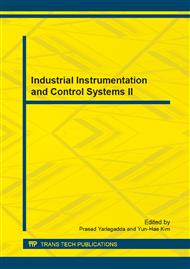p.248
p.253
p.257
p.261
p.265
p.269
p.273
p.277
p.281
Research of Event Localization in WSN Environmental Monitoring Based on Mobile Agent
Abstract:
Traditional events in WSN monitoring are usually localized based on beacon nodes. But due to the cost of this kind of node is hundreds times more than an ordinary one’s, localization algorithms can't ignore the sparse beacon nodes problem. In this paper, a novel event localization method based on mobile agent is proposed. By using the mobile agent which can dynamically enter and exit a network and autonomously clone and migrate themselves in response to environmental events, the proposed algorithm moves the processing function to the nodes in event area and identifies the boundary of the area by two-neighbor graph algorithm. Then the accurate location of event can be got and the approximate location where the event happens will be reported. Extensive simulation shows that the proposed method exhibits better performance in terms of energy consumption and the packet delivery ratio.
Info:
Periodical:
Pages:
265-268
Citation:
Online since:
July 2013
Authors:
Price:
Сopyright:
© 2013 Trans Tech Publications Ltd. All Rights Reserved
Share:
Citation:


